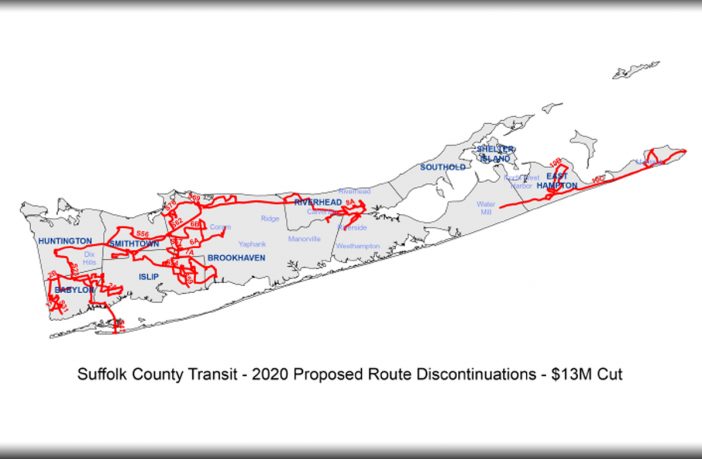Suffolk County Executive Steve Bellone has announced that the County will have no choice but to make significant reductions in Suffolk Bus transit services in the 2021 budget without significant federal disaster assistance. Through federal inaction, Suffolk County will be forced to eliminate several bus routes and cut services.
“Plain and simple, Washington’s inaction is an assault on our transportation system,” said Suffolk County Executive Bellone. “Public transportation is vital to our communities and essential workers. This should not be a political issue as both Democrats and Republicans alike support funding to local governments to stave off these types of cuts. Time is up, we need relief now.”
As a direct result of federal inaction, the County will be forced to discontinue 19 routes, which equates to 46 percent of all routes. These cuts will impact 2,300 rides daily, and total approximately $13 million in savings.
The following routes are slated to be discontinued:
- S54 – 548 riders per day
- 10B – 45 riders per day
- S59 – 90 riders per day
- S57 – 139 riders per day
- S31 – 12 riders per day
- S76 – 36 riders per day
- S56 – 89 riders per day
- 2A – 106 riders per day
- 7A – 60 riders per day
- 10C – 85 riders per day
- 6B – 108 riders per day
- S47 – 73 riders per day
- 8A – 131 riders per day
- S62 – 339 riders per day
- 1A – 63 riders per day
- 6A – 78 riders per day
- S69 – 3 riders per day
- 2B – 161 riders per day
- S23 – 149 riders per day
Suffolk County will also be forced to reduce the Suffolk County Accessible Transportation (SCAT) Service. These cuts would include elimination of paratransit service beyond ADA requirements and service into Nassau County, affecting 200 riders daily and saving approximately $5 million.
Cuts to SCAT will impact residents who cannot use SCT buses without assistance and those who have a disability that, combined with environmental barriers or circumstances, prevents them from accessing the County’s fixed route system.
It is estimated that the County will lose $6.1 million in fare revenue in 2020, and New York State has already announced that STOA funding will be cut by 20%, which equates to roughly $6 million. The County had previously received a one-time disbursement of $26.6 million in federal CARES Act assistance to support transportation. Given the reductions in fare revenue, state operating assistance, and sales tax revenue, which are all used to fund the operating expenses of the bus system, the CARES Act funding allowed the County to continue to provide the current level of transportation services without any curtailments for 2020 only. The total operating cost of Suffolk Transit is more than $85 million, with more than $43 million being funded by the County, more than $29 million from New York State, more than $4.4 million from the federal government, and $8.2 million in fares.
The County Executive also made a direct appeal to President Trump requesting that he call upon U.S. Senate Majority Leader Mitch McConnell to pass a federal disaster assistance bill in the U.S. Senate to prevent these potential devastating cuts. Earlier this year, the County Executive created a COVID-19 Fiscal Impact Task Force to conduct an independent review of the county’s multi-year plan and the true impact to the pandemic. The report found that Suffolk County could face a cumulative budget shortfall of up to $1.5 billion over the next three years because of the economic fallout of the pandemic.
In the wake of the COVID-19 pandemic, the New York State Association of Counties (NYSAC), a bipartisan organization comprised of 19 chief executives from counties across the state, announced that counties face a quadruple threat of declining local revenues, especially sales tax, but also hotel occupancy taxes, mortgage recording taxes, and gaming revenues. At the same time, counties are facing higher spending necessary to respond to health emergencies. There’s a potential loss in State Aid and significant losses for small businesses on Main Street that could threaten jobs and the property tax over the short and mid-term. Without further Federal assistant, the fiscal outlook for counties could become catastrophic.













